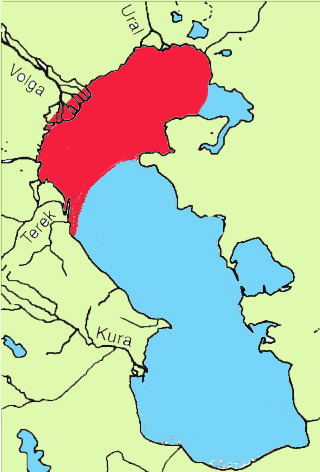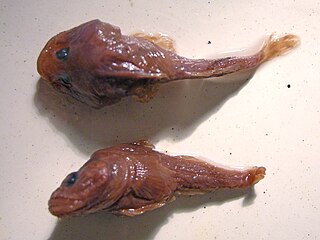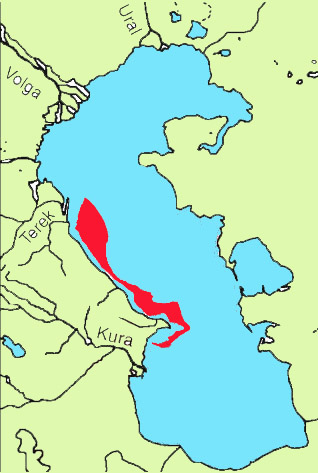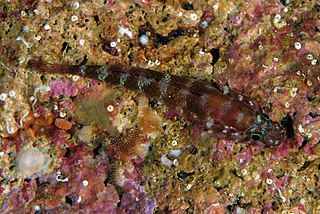
Knipowitschia is a genus of marine, fresh and brackish water gobies native to Eurasia. The genus name almost certainly honours Nikolai Mikhailovich Knipovich (1862-1938), a biologist who led a number of expeditions to the Caspian Sea.

The tadpole-gobies (Benthophilus), also called pugolovkas, are a genus of Ponto-Caspian fishes in the family Gobiidae.

The stellate tadpole-goby is a species of gobiid fish native to the basin of the Sea of Azov where it occurs in the Gulf of Taganrog and limans of the eastern coast. It also lives in the lower Don River up to the Tsimlyansk Reservoir. It occurs in fresh and brackish waters of depths greater than 3 metres (9.8 ft), preferring shallow coastal lagoons and lowland rivers. Males can reach a length of 13.5 centimetres (5.3 in) TL while females only reach 11 centimetres (4.3 in) TL.

The Black Sea tadpole-goby is a species of goby native to the basin of the Black Sea. Found in the Gulf of Tendra and limans of the north-western Black Sea, lakes of the Danube Delta. In the rivers of the Black Sea basin: Danube up to Iron Gate dam, Dniester up to Tighina, Dnieper up to Kyiv, Southern Bug. This species is mostly a denizen of fresh and slightly brackish bodies of water, preferring rivers and deltas, limans and coastal lakes. This fish can reach a length of 15 centimetres (5.9 in) TL.
Neogobius pallasi, the Caspian sand goby or the Caspian monkey goby, is a species of fish native to fresh and brackish waters of the Caspian Sea basin including the Volga drainage up to the vicinity of Moscow. It has been introduced into the Aral basin. This species of goby can reach a length of 20 centimetres (7.9 in) SL. It is also important to local commercial fisheries.

The Don tadpole-goby is a species of goby widespread in the basin of the Sea of Azov, specifically in the lower Don River and Tsimlyansk Reservoir. This species is found in rivers, reservoirs and river mouths, but is not known to enter seas. It is introduced and invasive upstream the Volga River, e.g. the Kuibyshev Reservoir. This fish can reach a length of 6.6 centimetres (2.6 in) SL. Life span is about one year.

The Azov tadpole goby is a species of goby native to the basin of the Sea of Azov, specifically in the near-estuary zone of the Kuban River, to west until Ukrainian part of the Taganrog Bay and the Strait of Kerch, in the Mius estuary, Yeya estuary, and Akhtanizovskii Liman. This species is only found on silty estuarine bottoms. It can reach a length of 8.4 centimetres (3.3 in) TL.

The Caspian tadpole goby is a species of goby which is widespread in the basin of the Caspian Sea, specifically in the near-estuary zone of the rivers and in small bays. It is a common species in the Volga River delta near Astrakhan, occurred in the deltas of rivers Terek, Ural, Samur. During the warmer months, this species prefers to live at depths of from .5 to 10 metres, moving in the colder months to depths of 20 to 25 metres. It can reach a length of 11.6 centimetres (4.6 in) TL.

The granular pugolovka is a species of gobiid fish widespread in the Caspian Sea. It is a small fish, with a length up to 5.6 centimetres (2.2 in) TL. It was listed as Least Concern by the IUCN in 2008: there are no known major threats. Granular pugolovkas are very abundant in their habitat due to their size and lack of natural predators. The common name 'pugolovka' is a Ukrainian word for tadpole.

The small-spine tadpole-goby is a species of goby, a small fish native to the eastern coasts of the Caspian Sea and the lower reaches of the Volga River up to Volgograd. In the sea it is recorded from the Cape Peschany to the Çeleken Peninsula and Ogurja Ada Island in the south. It is abundant the Volga River delta. This species can be found at depths down to 50 metres (160 ft) although the adults generally are not found deeper than 11 metres (36 ft). This species can reach a length of 6.6 centimetres (2.6 in) TL. The specific name honours the Azerbaijani ichthyologist A. A. Mahmudbekov, studied the fish of the Caspian Sea for much of his life.

Abdurahmanov's pugolovka is a brackishwater fish of family Gobiidae. It is found in the northern Caspian Sea and the lower reaches of the rivers Volga and Terek. FishBase treats this taxa as a subspecies of the Azov tadpole goby (Benthophilus magistri abdurahmanovi.

Benthophilus pinchuki, Pinchuk's pugolovka, is a species of gobiid fish found along the eastern and western coasts of the Caspian Sea, but absent on the middle part. This species has been recorded along the western coast from the Absheron to Iran, and along the eastern coast near the Cape Bely Bugor, Turkmenistan.

Benthophilus kessleri is a species of goby widespread along the eastern coasts of the Caspian Sea from the Urdyuk Cape to Kuuli Cape and Türkmenbaşy at south. This species occurs at depths of from 65 to 75 metres. It can reach a length of 4.6 centimetres (1.8 in) TL. The specific name honours the German-Russian zoologist Karl Fedorovich Kessler (1815-1881).

Benthophilus grimmi is a species of goby widespread in the northern Caspian Sea at depth 80 to 240 metres. This species is common from Chechen Island to Absheron Peninsula. This species can reach a length of 9.5 centimetres (3.7 in) TL. The specific name honours the Russian ichthyologist Oscar von Grimm (1845–1921), who was Chief Inspector of Russian Fisheries in the Russian Empire who collected the type specimen.

Couch's goby is a species of goby native to the northeastern Atlantic Ocean as far north as southern Great Britain and Ireland, the Mediterranean Sea and the Adriatic Sea where it can be found living under stones on muddy sand in inshore waters and in the intertidal zone. This species can reach a length of 7.7 centimetres (3.0 in) TL. The specific name and common name both honour Jonathan Couch (1789-1870), the Cornish ichthyologist and the author of A History of the Fishes of the British Islands published between 1862 and 1867.
Knipowitschia radovici, the Norin goby, is a species of goby endemic to Croatia where it only occurs in the drainage basin of the Neretva River, where adults inhabit the deepest parts of the rivers in the strongest current. This species can reach a length of 2.8 centimetres (1.1 in) SL. The specific name honours the Ornithologist Dragan Radović, a friend of the author, Marcelo Kovačić, who encouraged him to sample in the waterbodies of Croatia.

Pomatoschistus knerii, Kner's goby, is a species of goby native to the western basin of the Mediterranean Sea and the Adriatic Sea. This species occurs in areas with soft substrates near to rocks or beds of seagrass. The specific name most likely honours the Austrian ichthyologist Rudolf Kner (1810-1869), who was a friend of the author Franz Steindachner.
Knipowitschia iljini is a species of goby Endemic to the Caspian Sea, where it inhabits the deep waters in the central part. This species can reach a length of 4.7 centimetres (1.9 in) TL. The specific name honours the taxonomist of Gobiiformes Boris Sergeevich Iljin (1889-1958), who researched the gobies of the Black and Caspian seas.

Steinitz's goby is a species of goby. It is native to the Mediterranean Sea near Marseilles. It has been recently recorded in the Adriatic Sea in Croatia, Tyrrhenian Sea in Italy, and in the Black Sea in Ukraine. This species can be found in underwater grottoes in inshore waters at depths of 2 to 15 metres. Steinitz's goby can reach a length of 3.8 centimetres (1.5 in) SL. Its name honours the marine biologist and herpetologist Heinz Steinitz (1909-1971) of the Hebrew University, Jerusalem.
Hyrcanogobius bergi, the Volga dwarf goby, is a species of goby endemic to the Caspian Sea where it occurs in fresh, brackish and marine waters along the coast. Unusually for gobies, this species is almost a pelagic fish. This species grows to a length of 3.6 centimetres (1.4 in) SL. This species is the only known member of its genus. The specific name honours the Soviet zoologist Lev Berg (1876-1950) who described many new species of goby from the Caspian Sea.

















